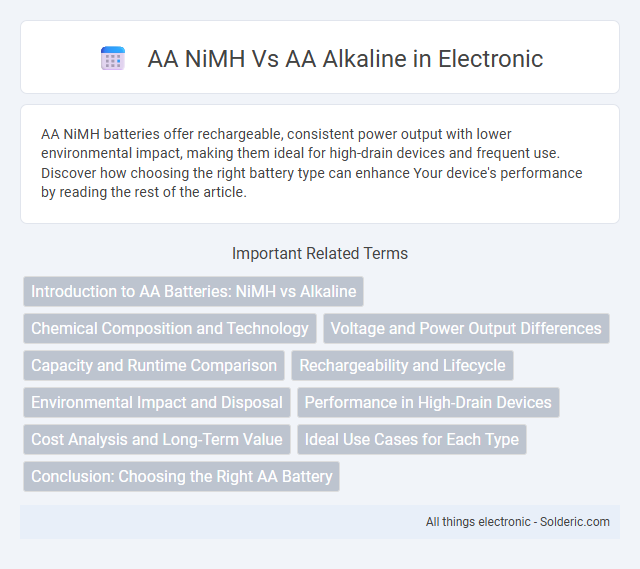AA NiMH batteries offer rechargeable, consistent power output with lower environmental impact, making them ideal for high-drain devices and frequent use. Discover how choosing the right battery type can enhance Your device's performance by reading the rest of the article.
Comparison Table
| Feature | AA NiMH | AA Alkaline |
|---|---|---|
| Chemistry | Nickel-Metal Hydride | Alkaline Manganese Dioxide |
| Voltage | 1.2V per cell | 1.5V per cell |
| Capacity | 1200-2800 mAh | 1800-2700 mAh |
| Rechargeability | Yes, hundreds of cycles | No, single use |
| Self-discharge rate | 20-30% per month | 2-3% per year |
| Best use | High-drain devices & frequent use | Low to moderate drain devices & infrequent use |
| Cost per cycle | Lower due to rechargeability | Higher, single use |
| Environmental impact | More eco-friendly, rechargeable | Disposable, more waste |
Introduction to AA Batteries: NiMH vs Alkaline
AA NiMH batteries offer rechargeable capabilities with typical capacities ranging from 1600 to 2500 mAh, providing consistent voltage output of 1.2V suitable for high-drain devices. In contrast, AA Alkaline batteries deliver single-use performance with capacities around 2000 to 3000 mAh and a nominal voltage of 1.5V, excelling in low-drain or intermittent-use applications. The choice between NiMH and Alkaline AA batteries depends on factors such as lifecycle cost, device power requirements, and environmental considerations.
Chemical Composition and Technology
AA NiMH batteries utilize a nickel-metal hydride chemical composition, which allows for higher capacity and rechargeability compared to AA alkaline batteries made with a zinc-manganese dioxide chemistry. NiMH batteries use a metal hydride alloy as the negative electrode and nickel oxyhydroxide as the positive electrode, enabling more efficient energy storage and longer cycle life. Your devices benefit from NiMH technology's stability and consistent voltage output, while alkaline batteries offer a lower initial cost but reduced rechargeability and shorter overall lifespan.
Voltage and Power Output Differences
AA NiMH batteries typically have a nominal voltage of 1.2 volts, while AA Alkaline batteries provide a higher nominal voltage of 1.5 volts, affecting the power output and device compatibility. NiMH batteries maintain a steadier voltage throughout their discharge cycle, ensuring more consistent performance in high-drain devices compared to Alkaline batteries, whose voltage drops gradually with use. Understanding these voltage and power output differences helps you choose the right battery type for optimal device efficiency and longevity.
Capacity and Runtime Comparison
AA NiMH batteries typically offer a capacity ranging from 1900 to 2500 mAh, providing longer runtime compared to AA alkaline batteries, which usually have a capacity between 1500 and 1700 mAh. NiMH batteries deliver a more consistent voltage output throughout their discharge cycle, resulting in better performance for high-drain devices such as digital cameras and gaming controllers. Alkaline batteries may have a longer shelf life but generally provide shorter runtime and reduced capacity under heavy load conditions.
Rechargeability and Lifecycle
AA NiMH batteries offer superior rechargeability, capable of withstanding up to 500-1000 charge cycles compared to AA Alkaline batteries, which are typically single-use and non-rechargeable. The extended lifecycle of AA NiMH batteries results in lower long-term costs and reduced environmental impact, making them ideal for devices requiring frequent battery replacement. Your choice should depend on usage frequency, with NiMH being more efficient for high-drain electronics and sustainable energy use.
Environmental Impact and Disposal
AA NiMH batteries have a lower environmental impact compared to AA Alkaline batteries due to their rechargeable nature, which reduces waste and the demand for raw materials. NiMH batteries contain fewer toxic metals, making their disposal less harmful to ecosystems when properly recycled. In contrast, AA Alkaline batteries are single-use, often discarded in landfills, where heavy metals can leach and pollute soil and groundwater.
Performance in High-Drain Devices
AA NiMH batteries deliver superior performance in high-drain devices such as digital cameras and handheld gaming consoles due to their higher discharge rates and consistent voltage output. In contrast, AA Alkaline batteries experience voltage drop under heavy loads, leading to reduced efficiency and shorter runtime. NiMH batteries' rechargeable nature also provides cost-effectiveness and environmental benefits for frequent usage in power-intensive electronics.
Cost Analysis and Long-Term Value
AA NiMH rechargeable batteries offer a higher upfront cost compared to AA alkaline batteries but provide significantly lower cost per use over time due to their ability to be recharged hundreds of times. Alkaline batteries, while cheaper initially, require frequent replacements, leading to higher long-term expenses and increased environmental waste. For frequent or high-drain device users, NiMH batteries deliver superior cost efficiency and value throughout their extended lifespan.
Ideal Use Cases for Each Type
AA NiMH batteries excel in high-drain devices such as digital cameras, cordless phones, and portable gaming devices due to their ability to provide consistent power output and recharge thousands of times. AA Alkaline batteries are better suited for low-drain devices like remote controls, wall clocks, and flashlights, offering longer shelf life and cost-effective single-use performance. Your choice depends on whether you prioritize rechargeability and consistent output (NiMH) or long storage life and occasional use (Alkaline).
Conclusion: Choosing the Right AA Battery
AA NiMH batteries offer higher capacity and better rechargeability, making them ideal for high-drain devices like digital cameras and gaming controllers. AA Alkaline batteries provide longer shelf life and lower initial cost, suitable for low-drain devices such as remote controls and clocks. Selecting the right AA battery depends on device power demands, frequency of use, and budget considerations.
AA NiMH vs AA Alkaline Infographic

 solderic.com
solderic.com